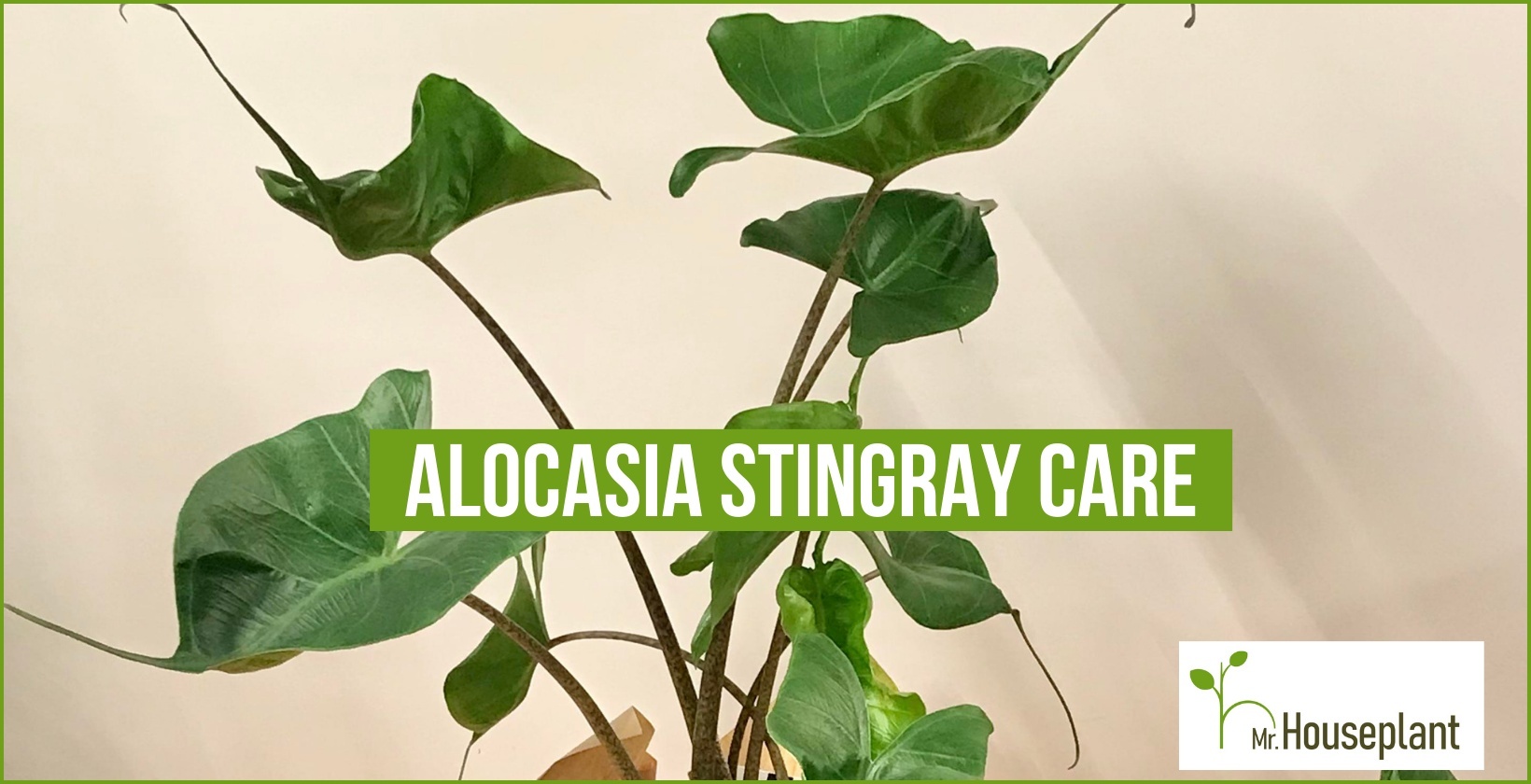
To give your Alocasia Stingray optimal care so it can thrive, read this plant care guide. This guide has everything you need to be a responsible Alocasia Stingray parent – from watering, light requirements, and fertilizing to soil and propagation. Keep reading to get detailed information about growing Alocasia Stingray.
| Botanical Name (Latin Name/Scientific Name): | Alocasia Macrorrhiza Stingray, Alocasia Macrorrhizos Stingray |
| Common Name: | Alocasia Stingray |
| Light: | medium light (1,000+ lux; 100+ foot candles) |
| Watering: | water once the top half of the soil is dry |
| Soil: | well-draining, chunky potting mix |
| Repotting: | once a year or when the roots come out of the drainage holes |
| Fertilizing: | during active growth with every watering with a high-nitrogen fertilizer |
| Temperature: | warm temperatures between 65°and 75°F (18° and 24°C) |
| Humidity: | high humidity (60% to 80%), but it adapts well to lower humidity |
| Toxicity for Pets: | Yes (lips, mouth, tongue irritation and swelling, drooling, vomiting, swallowing issues) |
| Toxicity for Humans: | Yes (skin irritation, lips, mouth, tongue, and throat irritation and swelling, breathing difficulties) |
| Propagation: |
|
| Pruning: | prune dead or diseased growth or when you want the plant to branch out |
Alocasia Stingray is a unique-looking tropical houseplant known for its distinctive foliage. This Alocasia has stingray-shaped leaves with a long tail resembling a stingray and patterned stems that resemble Alocasia Zebrina. This indoor plant is a mutation of Alocasia Macrorrhiza.
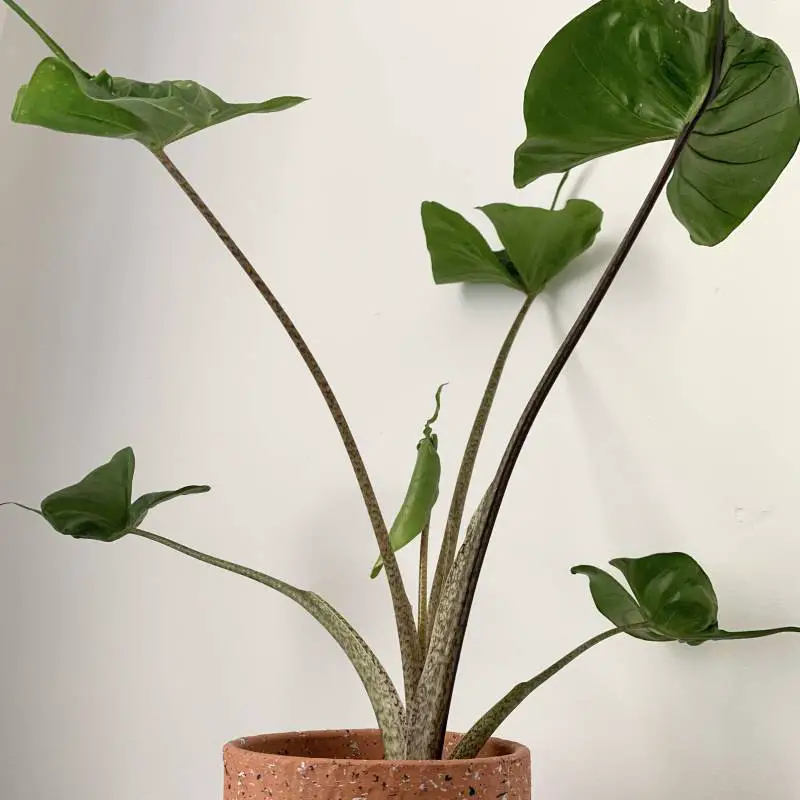
Alocasia Stingray plant. Photo of the plant by: Kiah96
Alocasia Stingray Plant Care
Alocasia Stingray Plant care is easy. If you provide your Alocasia Stingray with enough bright light (over 1,000 lux), if you don’t let the soil fully dry out, and provide a chunky and well-draining soil, it will flourish and reward you with lush tropical foliage.
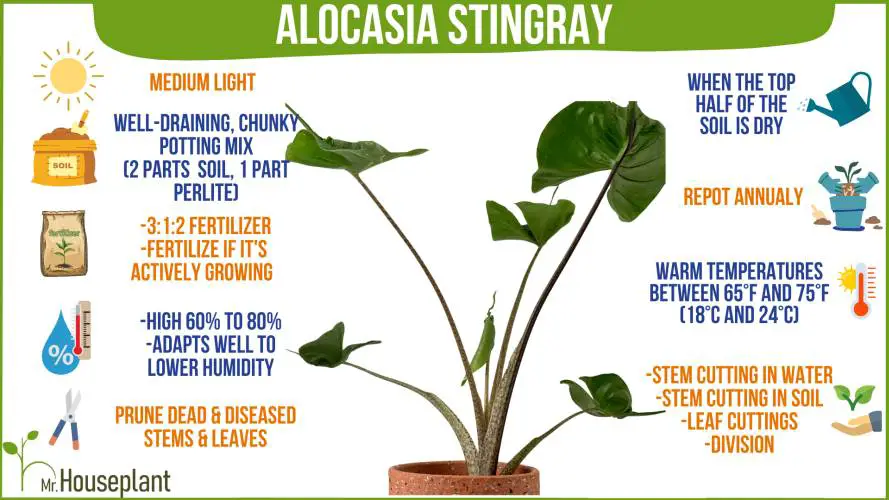
Follow these care steps for your Alocasia Stingray plant. Photo of the plant by: Kiah96
Light Requirements
| Minimal amount of light: | 1,000+ lux (100+ FC) |
| Optimal amount of light: | 3,000+ lux (300+ FC) |
| Direct sun tolerance: | 3-4 hours of early morning or late afternoon direct sun |
| Category: | Medium light |
Alocasia Stingray plant does best in bright indirect light (over 3,000 lux / 300+ foot candles). Since Alocasia Stingray is an understory plant in its native habitat, it can tolerate medium light levels. However, it will not thrive in medium light and it may fail to flower.
Alocasia Stingray grows well in bright indirect light, but it doesn’t tolerate long exposure to direct sun. Since prolonged exposure to direct sunlight can damage its leaves and affect photosynthesis, it’s best to expose it only briefly to early morning or late afternoon direct sun (no more than 3-4 hours). East or west facing windows are a great choice.
Water Needs
Water Alocasia Stingray once the top half of the soil dries out. This plant doesn’t like for the soil to get fully dry before watering. The standard way to assess if your Alocasia Stingray is thirsty is to use a chopstick. Take a chopstick and stick it to the bottom of the pot. Take it out and if the top half comes out completely dry, with no soil clinging to it, it’s time to water your Stingray Alocasia.
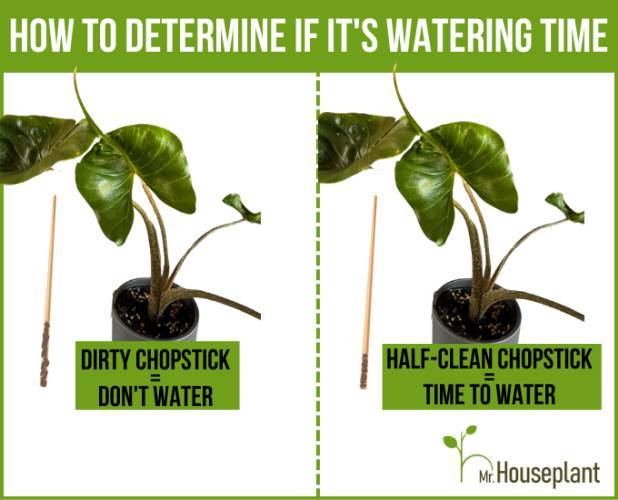
Dirty chopstick means to wait more before watering. Once the chopstick is clean and dry it’s time to water the plant. Photo of the plant by: ibreedsnakes
Humidity Needs
Optimal humidity levels for Alocasia Stingray are between 60% and 80%. Even though this plant prefers warm and humid environments, it can adapt well to lower humidity levels. Lower humidity will make it more prone to pests.
Temperature Requirements
The Alocasia Stingray plant, like its other tropical relatives, thrives in warm temperatures, between 65° and 75°F (18° and 24°C). Avoid keeping the Stingray Alocasia plants in temperatures lower than 60°F (16°C) as this can cause the plant to start going into dormancy.
Fertilizing
Fertilize Alocasia Stingray during active growth with every watering using a liquid fertilizer with a 3:1:2 NPK ratio. Only fertilize your tropical plant when it’s actively growing. This way it will be able to absorb and utilize all the nutrients and minerals. Otherwise, the minerals will accumulate in the soil, and the plant won’t be able to use them. This can lead to root damage and subsequently leaf damage.
Always make sure to carefully follow the instructions written on the label, as overfertilizing can damage your Alocasia Stingray.
Soil
Stingray Alocasia plant will grow well in a well-draining, chunky potting mix. You can make well-draining soil by mixing 3 parts of store-bought potting soil with 1 part perlite and 1 part bark. It’s advisable to use chunky amendments with larger particles as this will create macro pores that contain oxygen. Adequate soil aeration is vital for root health and it helps keep fungal diseases at bay.
Repotting
To repot your Alocasia Stingray take the following steps:
- Gently take the plant out of its pot
- Loosen the rootball carefully
- Inspect the rootball
- If you notice any dead, smelly, mushy, or diseased roots, cut them off
- Fill up ⅓ of the new pot with fresh soil (mix 3 parts soil with 1 part perlite and 1 part bark. Pots with drainage holes are optimal, because the surplus water can be expelled)
- Place your Alocasia Stingray into its new pot
- Fill up the pot with fresh soil
- Gently press the soil around your Alocasia Stingray
- Wait for the top half of the soil to dry out before you water
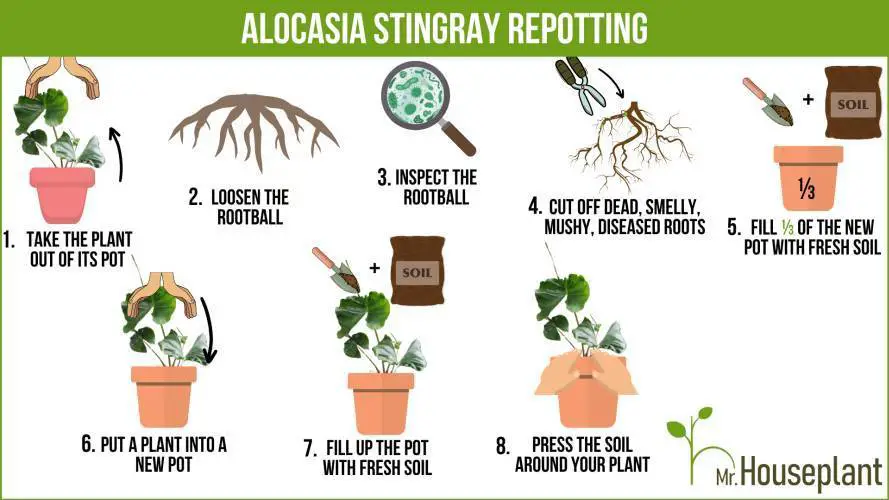
Follow these steps to repot the Stingray Alocasia plant. Photo of the plant: wild_bloom_boom
You should repot your plant if it overgrows its container. You will know this if you see the plant’s roots coming out of the drainage holes. This is a sign that your Alocasia Stingray needs to be repotted into a one-size larger container so it has room for growth. Even if it doesn’t overgrow its container, you should repot it once a year so it can get nutrients from fresh soil and continue growing in non-compacted soil.
Here is the video of Alocasia Stingray repotting:
Toxicity To Humans
Alocasia Stingray is toxic to humans. The California Poison Control System (CPCS) states that oxalate crystals found in the juice and sap of this plant, if ingested, will cause irritation and pain in the upper respiratory tract such as the mouth, lips, and tongue. Additionally, it can lead to swollen throat and problems with breathing.

Alocasia Stingray is toxic to you and your family. Photo of the plant by: justanothrsomeone
Toxicity To Pets
Alocasia Stingray is toxic to pets. If animals eat it, it can cause problems such as difficulty swallowing, vomiting, and drooling. The American Society For The Prevention Of Cruelty To Animals also confirms that pain and swelling of the mouth, lips, and tongue are possible.
Ann King Filmer, a Plant Scientist from the University of California, confirms in her publication “Safe and Poisonous Garden Plants” from October 2012 that oxalate crystals from the plant can irritate the skin. Also, if chewed, they can cause stomach upset, swollen throat, pain, and breathing difficulties.
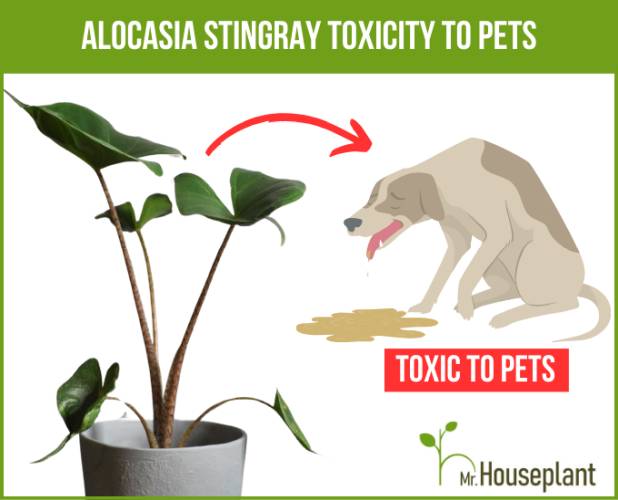
Alocasia Stingray is toxic to your pets. Photo of the plant by: justanothrsomeone
Pruning
Prune your Alocasia Stingray during the growing season. Prune it sparingly, when needed to remove dead or damaged leaves. To prune dead leaves from your Alocasia, cut the stems near the bottom of the plant with clean, sharp pruning shears.
Flowering
The flowers of alocasia stingray look similar to peace lily flowers. They have a white spathe and have no fragrance. The flowers are about 5 inch tall (10 cm) and 2-3 inches (5-7.5 cm) wide. Alocasias require a long time before they can produce flowers. And they also need a lot of light to be able to produce flowers. Once the flower is fully grown it lasts several days.
Propagation
There are several ways to properly propagate Alocasia Stingray listed below:
- stem cutting propagation in water
- stem cutting propagation in soil
- air layering propagation
- division
Air layering is the best way to propagate because there is no risk for your Alocasia.
Air Layering Propagation Method
To propagate Alocasia via air layering take some sphagnum moss, moisten it, squeeze to remove excess water, wrap tightly around the stem, and cover with plastic. Make sure the moss is fully enclosed in the plastic, so it doesn’t dry out. After a few week a few inches of roots will grow on the stem. At that point it’s okay to cut the stem and pot it in soil.
The goal of covering with plastic is to keep the main stem moist so it can grow roots. If you notice moss drying out, unwrap the plastic, mist the moss, and wrap the stem back up.
To make things easier, I suggest waiting until you see a large rootball inside the plastic and the roots growing everywhere throughout the moss. A larger root mass will help the cutting absorb water better once you cut it and pot it in soil. To reduce the chances to infect your Alocasia Stingray, sterilize your pruning shears just prior to making the cut.
Check out the full video on Alocasia air layering below:
Pests And Diseases
Alocasia Stingray plant is a sturdy plant that isn’t often affected by pests and diseases. However, it can occasionally be infested with spider mites, fungus gnats and springtails. It can also be affected by root rot from overwatering and lack of light.
Common Problems
Yellow Leaves
Alocasia Stingray can have yellow leaves due to several reasons: improper watering (overwatering or underwatering), lack of light, pests, nutrient imbalance, or leaf senescence. Improve watering practices by watering the soil when the top half is dry. Give your plant bright, indirect light (over 3,000 lux). Check for signs of pests and treat them with pest control methods. Fertilize your Alocasia Stingray with a high-nitrogen fertilizer with every watering and ensure that you’ve done so according to the instructions on the package.
If you’ve done all of this and you’re having yellow leaves, it it likely normal leaf senescence (leaf loss). It’s normal for old leaves to die. The number of leaves your plant will have at any given moment depends on the amount of light it’s receiving. More light equals more leaves.
Here is a video of Alocasia Stingray leaves turning yellow
Brown Leaves
Stingray Alocasia can have brown edges due to sunburn, underwatering, overwatering, overfertilizing or pests. Avoid exposing your Alocasia Macrorrhizos Stingray to direct sunlight for more than 3-4 hours. Make sure to water the plant once the top half of the soil has dried out. Fertilize the plant only when it’s actively growing to avoid nutrient accumulation in the soil. Check and treat for pests.
If the whole leaf is dry and brown, this is normal leaf loss. As the plant is putting out new leaves, older leaves will die and dry out.
FAQ
Are Alocasia Stingray rare?
Alocasia Stingray is a new, rare form of Elephant’s Ear plant with large deep green color leaves that grows well in partial shade outdoors and medium and bright light indoors.
How Big Can Alocasia Stingray Get?
Alocasia Stingray mature plants can grow to a height of about 150 cm (4.9 feet).
Conclusion
Alocasia Stingray is an easy-to-grow plant with unique shape and long upturned tail on its leaves. If you meet its care requirements – bright indirect light and watering once the top half of the soil dries out, it will be happy. If you apply all the tips and trick from this care guide, you will certainly be a proud plant parent of a lush and healthy Alocasia Stingray plant.
Yours Truly,



Related Posts
Sansevieria Black Gold (Snake Plant Care GUIDE!)
Spathiphyllum Sensation (FULLY Explained!)
Peperomia Verticillata ‘Red Log’